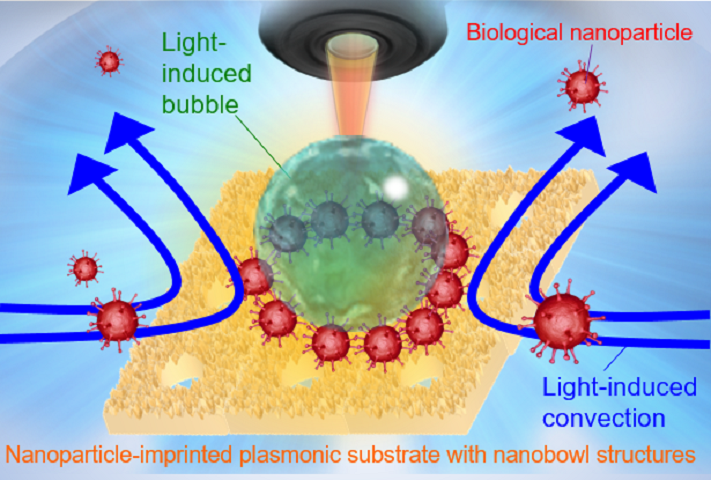Research News
Sep 19, 2024
- Science
- Engineering
- Research Centers
Lights, camera, action! Coronavirus spike proteins can be selectively detected in 5 minutes
Light-induced immunoassay coated with novel coronavirus spike proteins found highly sensitive even with weak light like a laser pointer
Using a light-induced immunoassay to detect viruses
A low-power laser can cause bubbles to form and convection to move nanoparticles so that they gather at an assembly site on an antibody-coated substrate, accelerating their detection.
Credit: Osaka Metropolitan University

Like moths to a flame, microbes can also be moved by light. Using this knowledge, researchers from Osaka Metropolitan University’s Research Institute for Light-induced Acceleration System (RILACS) have demonstrated a method to detect the presence of viruses quickly and using only a small sample.
The research team led by OMU Professor Takuya Iida, the director of RILACS, and Associate Professor Shiho Tokonami, the deputy director, report in npj Biosensing on a light-induced immunoassay. Using laser irradiation for less than 1 minute, a nanoparticle-imprinted plasmonic substrate with a series of nanobowl structures (500 nm in diameter for each) could be coated with antibodies for the spike proteins of the novel coronavirus. A 5-milliwatt laser, as low power as commercial laser pointers, could then form bubbles on the biochip that drew virus-mimicking nanoparticles, thereby accelerating the selective detection of the particles.
Because light-induced convection helps move the nanoparticles around so that they end up assembling at the stagnant region between the substrate surface and the bottom of the bubble, a high concentration of the particles was not required. In under 5 minutes, the entire process, from substrate coating to detection, could be completed.
“This study shows that we can shorten the cumbersome antibody coating process and perform rapid and highly sensitive protein detection,” Professor Iida proclaimed. “We believe our findings can contribute to the early diagnosis of not only the novel coronavirus, but possibly also various infectious diseases, cancer, even dementia.”
Funding
This work was supported by the JST-Mirai Program (No. JPMJMI18GA, No. JPMJMI21G1), Japan Agency for Medical Research and Development (AMED) (No. JP20he0622017), a Grant-in-Aid for Scientific Research (A) (No. JP17H00856, No. JP21H04964), JST FOREST Program (No. JPMJFR201O), a Grant-in-Aid for Scientific Research (B) (No. JP18H03522), Scientific Research on Innovative Areas (No. JP16H06507), Grant-in-Aid for Early-Career Scientists (No. JP20K15196), Grant-in-Aid for JSPS Fellows (No. JP23KJ1851, No. JP21J21304), Grant-in-Aid for Transformative Research Areas (A) Publicly Offered Research (No. JP23H04594) from JSPS KAKENHI, and the Key Project Grant Program of the Osaka Prefecture University.
Paper information
Journal: npj Biosensing
Title: High-throughput light-induced immunoassay with milliwatt-level laser under one-minute optical antibody-coating on nanoparticle-imprinted substrate
DOI: 10.1038/s44328-024-00004-z
Authors: Masatoshi Kanoda, Kota Hayashi, Yumiko Takagi, Mamoru Tamura, Shiho Tokonami, and Takuya Iida
Published: 26 June 2024
URL: https://doi.org/10.1038/s44328-024-00004-z
Contact
Takuya Iida
Graduate School of Science & Research Institute for Light-induced Acceleration System (RILACS)
Email: t-iida[at]omu.ac.jp
*Please change [at] to @.
Shiho Tokonami
Graduate School of Engineering & Research Institute for Light-induced Acceleration System (RILACS)
Email: tokonami [at]omu.ac.jp
*Please change [at] to @.
SDGs

